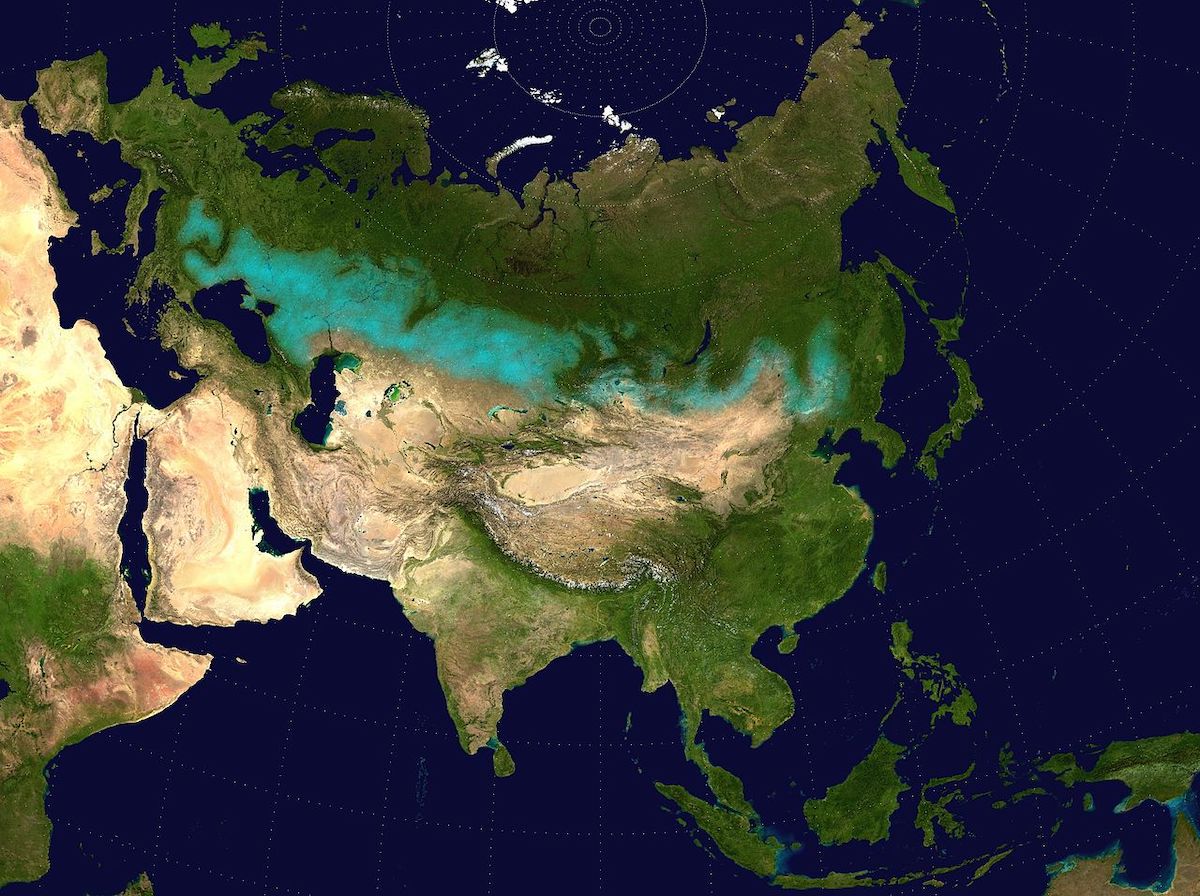Hypothesis
Origins and Exploration—An Interview with Dr. Lewis Dartnell
One of the big questions in evolutionary biology is: what drove our evolution from tree-swinging apes to bipedal, highly intelligent homonins that went on to build civilization and inherit the world?

Dr. Lewis Dartnell is an award-winning research scientist in the field of astrobiology. In his most recent book, the Sunday Times bestseller Origins: How the Earth Made Us, Dartnell tells the story of how cosmic and geological forces have directed the evolution of humans and their civilizations. The following is an interview with Dr. Dartnell about Origins, as well as his field of expertise, astrobiology—the search for life in the universe.
* * *
Logan Chipkin: Early in Origins, you describe a fascinating hypothesis which causally links the cosmic movements of Earth with the evolution of human intelligence. What is this hypothesis, in detail?

Lewis Dartnell: One of the big questions in evolutionary biology is: what drove our evolution from tree-swinging apes to bipedal, highly intelligent homonins that went on to build civilization and inherit the world? Primarily, what needs to happen is that the land around you needs to dry out, the forests need to be replaced by grasslands, by savannah. And what was driving that process over 5–6 million years since we diverged from the chimpanzee lineage was that East Africa dried out, because it was being pushed upwards. So the Ethiopian highlands were rising, probably because a magma plume beneath the crust of the planet was rising up in the interior. That also drove this splitting of the crust itself in a characteristic Y-shaped fracture, with two of those arms being the Red Sea and the Gulf of Aden, which then flooded in with the sea. And the third arm is the Great East African Rift Valley, which serves to block the moisture-rich air from either the ocean or from the rainforest in the interior of Africa from blowing over to East Africa until it’s dried out. So, what should be rainforest in East Africa has now dried out and is savannah, is grassland.
But the bigger question, what’s been puzzling paleontologists for a while, is what was it specifically about the Rift Valley in East Africa that created us as such an exquisitely intelligent species of ape. And the answer that’s been emerging over recent years is that the particular landscape of the Rift Valley—where the contrast between high mountainous ridges that shoulder either side of the Rift and the very low valley floor which is very hot and dry—means that there are lakes in that Rift Valley that are very sensitive to the precise balance between precipitation and evaporation, i.e., how much rain there is and how quickly it evaporates back away again. And that tectonic landscape interacts with what’s known as the Milankovitch cycle—these cosmic cycles of Earth’s orbit or its tilt, which cause slight variations in the amount of rain that the tropics experience.
So there is this whole set, this string of lakes on the Rift Valley floor, that in certain periods of time flicker rapidly in and out like loose light bulbs (they’ve been called “amplifier lakes”). This creates an unstable, rapidly fluctuating climate. The idea is that in this rapidly changing environment, we had to evolve intelligence to be able to survive.
LC: You argue that the “aimless wandering of the continents into their current configuration” indirectly “gave the civilizations of Eurasia a great developmental advantage through history.” How did Earth’s geography at the dawn of civilization advantage Eurasian civilizations and disadvantage those outside Eurasia?
LD: This is similar to the stuff that Jared Diamond had covered in Guns, Germs, and Steel, although he was looking specifically at Eurasia versus the Americas. And there are other arguments as to why Africa never developed civilization that became dominant in the way that European civilizations did. Ditto with Australasia. But regarding just Eurasia and the Americas— when the supercontinent Pangea broke up during the last great supercontinent cycle, it just so happened that one big chunk of it that became Eurasia was a huge, east-west oriented landmass. On the other hand, the Americas were ripped off by different tectonic faulting processes, and so they were pulled away into a predominantly north-south orientated continent.

And one of the main differences that that gives you for agricultural civilizations is that it is relatively easy to move domesticated crop species along the same line of latitude, i.e., east-west, because you have generally the same seasonality, length of day, that sort of thing, which is important to plants. So that meant that across Eurasia, things like cotton, rice, or wheat could be moved relatively easily between all civilizations across the continent, whereas in the Americas, which is north-south, it was much harder and slower to move crops around. One of the reasons why American societies were biologically disadvantaged is that it was harder for them to move their crops between different locations.
There’s another quirk of that distinction between Eurasia and the Americas, which is that the Americas were impoverished in the selection of large mammal species that could be domesticated, whereas Eurasia had a lot more. And part of the reason for that is that the first humans to migrate to the Americas across the Bering land bridge probably triggered a mega fauna extinction, which is something I talk about in the book. So there are both plant- and animal-related reasons why the Americas were biologically held back, and this is a broad brushstroke, grand theme of history.
LC: I did think of Guns, Germs, and Steel when reading your book.
LD: Yeah, I was delighted when some of the newspaper reviews in the U.K. compared Origins to Guns, Germs, and Steel and also to Sapiens, by Yuval Noah Harari. While Guns, Germs, and Steel was a great book, it only looked at a few of these deep causal links, and what I wanted to explore in Origins was that I thought there were more links in these chains of causation that could be used to explore the whole of human history.
LC: I don’t recall reading about the causal link between Earth’s cosmic cycles and human evolution in Guns, Germs, and Steel. That idea seems pretty new.
LD: Yeah, and there’s a lot of stuff that hasn’t really been talked about, such as the influence of the oceans’ dynamics on the Age of Exploration, and on building these transcontinental trade routes, which was the beginning of globalization.
LC: You write a lot in Origins about the friction between settled civilizations and nomadic peoples throughout history. How were two dramatically different lifestyles adopted in the same species, and why did they sometimes violently clash?
LD: This comes down to one of the fundamental contrasts within the Eurasian landmass. You have these different climate bands that are layered from the equator to the poles of planet Earth, and the important one for this part of the story is what is essentially the temperate climate band, where it is mild, moist, and rainy enough that you can support agriculture to grow enough food for agrarian societies, and therefore cities, and therefore settled civilizations built on growing crops in the ground.
Further to the north, you have a great stripe of a climate band across the very backbone of Eurasia, which are the steppes, the grasslands of Eurasia. And these are much more arid, which means that you cannot effectively grow enough food for yourself by using agriculture, but they do support very well an alternative mode of life, which is nomadic pastoralism, i.e., herding huge numbers of goat, sheep, or cattle. They eat the grass, which humans cannot eat themselves, and therefore humans are essentially using those herbivorous animals almost like processing machines to turn inedible grass into meat and milk that humans can digest.

This all leads to two fundamentally different and antagonistic lifestyles. And so throughout Eurasian history, going back to the Bronze age through to the 1700s, periodically and probably pressured by regional climate change within the steppes, the nomadic horse-riding peoples are driven out of their homeland to raid or invade the settled civilizations around the rim of Eurasia. This is very familiar from classical history, such as when the Huns appeared out of the steppes and triggered the collapse of the Western Roman Empire. It happened again with the Mongols, thundering out of the steppes and building the largest land empire that the world has ever seen by unifying the lands across the steppes. Throughout history, the Chinese had been repeatedly harassed by people they had called barbarians—horse riders coming out of the steppes. When you look at it in this light of planetary science interacting with history, the Great Wall of China is not just a defensive barrier, but it effectively follows this boundary, this line between two different ecological systems—between the temperate zone where you can grow crops, and the steppes where you have to be nomadic and herd sheep and ride horses.
LC: In Origins, you explain the emergence of different societal organizations as a result of particular ecological circumstances. Are you arguing for a kind of ecological determinism, such that the great civilizations were always going to emerge where they did on Earth, and not elsewhere?
LD: I think one needs to be very careful to hint or imply things like geographical determinism. Historically, arguments within geographical determinism have been used as excuses or to justify territorial expansionism, or racism and colonialism, or slavery. So the idea that one people is intrinsically or naturally linked to one part of the world, to a particular territory, to a particular location, is not what I’m talking about. Nor am I saying that some peoples are inherently better, or brighter, or advance more quickly, than others.
What I am saying is that you don’t want to throw the baby out with the bathwater. Undeniably, there is a deep link between physical, geographical features of the planet, or the atmosphere, or the ocean, and what opportunities or challenges that those have given people through the ages. And so some of the things we’ve been talking about, such as the climate bands of Eurasia, those would be there even if you rewound history back to 100,000 BC and pushed the play button again. Those physical features of the planet would be the same, and they would therefore have a similar driver or influence or effect on the subsequent development of, in this example, nomadic societies or settled civilizations. The pattern of winds around the world, driven by atmospheric circulation and dynamics, they would be exactly the same, so you would be able to have trade routes along similar lines, simply because of the physics of the atmosphere. So if you look in broad enough brushstrokes, both in terms of historical time and planetary scale, you can be fairly confident in your predictions about how such geographical features would affect the human story. But you can’t start predicting particular things, such as whether a particular war, or a particular leader came about because of geographical features.
LC: Your answer sounds like an argument against genetic determinism.
LD: The genetics across the entire human race are basically identical. As I point out in the book, there is more genetic diversity between two troops of monkeys on opposite sides of a river in Central Africa than there is in the 6 billion people living across the world outside of Africa. So in that sense, it’s not genetics that caused Eurasian civilizations to become technologically more advanced than American civilizations in the early 1500s. We are the same people, the same species. It was more these geological and geographical influences that were important.
LC: Astrobiology is the quest to understand the origin, evolution, distribution, and future of life in the Universe. Since you’ve begun your research career as an astrobiologist, in which of these subfields have we made the most progress, and what have we learned in that subfield?
LD: Astrobiology is a very interdisciplinary science. I came from a biology background, but I have friends that come from geology, planetary science, chemistry, astronomy, engineering, and so on. Astrobiology really is the thin sliver of overlap right in the middle of a huge Venn diagram of different disciplines. Over the last 15–20 years, we’ve been making huge advances in basically all of those fields. And so you might pick out things like extremophiles and our realization that life on Earth is in fact incredibly adaptable and tolerant of a huge range of different hostile environments, and therefore places like Mars are habitable in that sense. Or we’ve been discovering solar systems beyond our own star, our own Sun, and we are finding more and more Earth-like extrasolar planets, so there have been huge advances in that field as well. Or in our capabilities with robotics and instrumentation and exploring planets like Mars by sending our robotic emissaries, our robotic explorers to do what humans are not able to do just yet.
So there have been big advances in those areas as well as in many others within astrobiology that have been giving us increasing optimism that we are on the verge of discovering life on other planets if it’s there. It very well could be our generation that makes that profound discovery.
LC: What has recent research taught us about what features we expect life to have, should we discover it elsewhere?
LD: Within astrobiology, you try to base your expectations, your experiments, and your instruments on what is already known. So we base these on what we know of terrestrial biology and what sort of chemistries can enable something as complicated and complex as even a single-celled organism. But you also don’t want to be blinkered—you want to keep an open mind about how life could be different from our example. If life is extraterrestrial and alien, then by definition it could be different from us. So you’re trying to play off those two poles. When we go looking for life on Mars, for example, we’re not looking for a particular molecule—we’re not looking for DNA itself. We would look for complex organic chemistry in general, the sort of chemistry that you would not expect to have arisen in the absence of life, molecules that would not have been synthesized by geochemistry or by astrochemistry, but only by biochemistry—by the organization and direction that an organism can muster.
So in broad brushstrokes, we look for organic-based chemistry, carbon-based chemistry, and water-based life, although possibly on somewhere like Titan (one of Saturn’s moons), we should relax the assumption that life would be water-based. There, it might be methane-based or ammonia-based, there might be other solvents for life—other wet stuff that biochemistry and cells could be built on, but probably using carbon chemistry. Life, wherever you find it, will probably be organic (based on carbon compounds).

LC: Do you expect there to be an information code wherever we find life?
LD: Life seemingly has three core features. The first is that it should have some kind of complicated chemical network to extract energy from the environment and to synthesize the building blocks, the Lego bricks, of new cells, so life needs some kind of biochemistry, some kind of metabolic network. It would also need some kind of information storage retrieval and transmission system. We use DNA for that, for our genetics. And then it would need some kind of membrane, some kind of bag or sack around the cell, to simply delineate itself from the environment, so it can control its internal conditions. Those are three things that all cells on Earth have, and you can therefore start making expectations about what chemistry or molecules those three things might be built out of. But life is a process, life is a function, not an object, if you think about it that way.
LC: What is the shadow biosphere, and what could it tell us about the possibility for life in the Universe?
LD: We know that all life we’ve discovered so far on Earth is related. We can all be put as twigs onto the same huge evolutionary tree. And at the root of that, there is a progenitor—a last universal common ancestor (LUCA). But the fact that all life we’ve discovered on Earth can be traced to the same LUCA does not mean that life only evolved once on Earth. It just means that we are all the survivors of the same origin. And it stands to reason that if the conditions on Earth were appropriate for chemistry to become biochemistry to become life, then that wouldn’t have happened at just one location. It would’ve happened at several locations. And perhaps it’s not true that our form of life outcompeted all other forms.
Perhaps there are locations on Earth where we were not able to colonize as effectively, where the descendants of some other origin of life on Earth remain even today. Perhaps in extreme environments where our form of biochemistry falls apart, so maybe at very high temperatures, maybe in the depths of a hydrothermal vents, maybe deep in the Earth’s crust. These are the sort of places where we might expect to find what has come to be known as a shadow biosphere—life that is in some sense alien, even though it was born and lives on the same planet that we do. It would nevertheless be life that is based on a fundamentally different biochemistry because it came from a different origin event, a different genesis. The problem with that, though, is, how would you find something which is different from what you are familiar with? So in that sense, it’s a similar problem to that of looking for life on Mars—we’re looking for other Earthlings but with a very different biochemistry on our own planet.
And maybe there’s not just one shadow biosphere, maybe there are many. But you start having difficulties explaining how that situation would be stable. You would expect, even if there are different biochemistries, for one to start outcompeting the others, in the same way that if you have many species living in the same niche on earth, they start outcompeting each other, and only one prevails. So there might be one other shadow biosphere, but it’s hard to understand how lots of different shadow biospheres would be a stable system and not have outcompeted each other.
LC: What recent steps have scientists taken to look for life in our solar system and beyond?
LD: We’re designing probes to launch to Mars, and next year, 2020, both NASA and ESA (the European Space Agency) are sending their own rovers to look for signs of life on Mars, and that’s NASA’s Mars 2020 and ESA’s ExoMars rover. ExoMars is particularly interesting, because it will have a two-meter long drill onboard, so it will be able to get underground on Mars, and then pull handfuls of Martian dirt back up the surface. It’ll then be analyzed for signs of organic molecules and hopefully even biosignatures—signs of life itself, whether it’s extinct or not.
And there are plans on the drawing board for missions out to Europa (one of Jupiter’s moons), which is considered to be another habitable zone, another potential site of extraterrestrial life in our solar system. And then with the extrasolar planets outside our solar system and across the galaxy as a whole, we’re building steadily more capable space telescopes and ground-based observatories that not only detect that a planet is there, but actually could characterize that planet for us. And so we would start looking for planets in what is known as the habitable zone, or the Goldilocks zone, around the star. We would then start analyzing the light from the planet and start looking for the telltale fingerprint of gases like oxygen and methane, which, in combination, would be a very indicative biosignature, strongly suggesting that there is life, and specifically photosynthetic life, on that Earth-like planet.
LC: What are the most exciting astrobiology research projects in the near future?
LD: I’m very excited about next year’s space missions on ExoMars and Mars 2020, which I’ve mentioned. It would be good to look into the future a bit more with ESA’s JUICE mission (the Jupiter Icy moons Explorer), which would hopefully give us more information about Europa, which could lead to the construction of a dedicated Europa probe. So, if you’re looking towards the horizon, those are the most exciting upcoming space missions.






